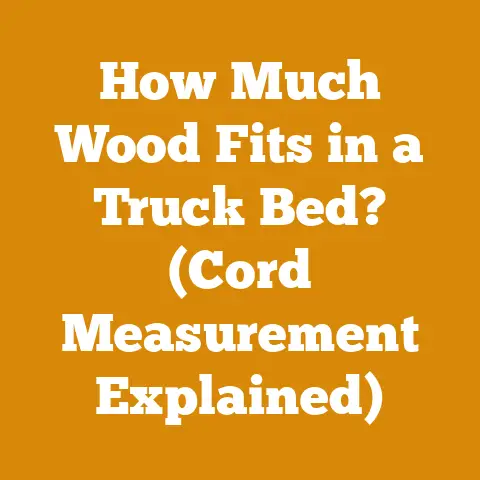Where Can I Rent a Forestry Mulcher? (5 Pro Tips Inside)
I’ve heard the whispers, the campfire tales of forestry mulchers – machines of legend that can tame unruly landscapes and turn tangled forests into manageable terrain. But before we dive into where you can actually find one to rent, let’s address a common misconception: the myth of indestructible machinery.
These machines are powerful, no doubt. But they are not impervious to damage. I’ve seen seasoned professionals bring even the toughest mulchers to their knees by neglecting maintenance, pushing them beyond their limits, or simply encountering hidden obstacles. So, remember, respecting your equipment is paramount, no matter how “heavy-duty” it claims to be.
Where Can I Rent a Forestry Mulcher? (5 Pro Tips Inside)
Finding the right forestry mulcher for your project can feel like searching for a needle in a haystack. But fear not! I’ll guide you through the process, highlighting key rental sources and offering pro tips to ensure a smooth and productive experience.
Understanding Your Needs: A Crucial First Step
Before you even think about contacting rental companies, you need a clear understanding of your project’s scope. What type of vegetation are you dealing with? What’s the terrain like? How much area needs to be cleared? Answering these questions will determine the type of mulcher you need and prevent you from renting an unsuitable machine.
- Vegetation Type: Are you tackling dense hardwoods, softwoods, brush, or a mix? Hardwoods require more powerful mulchers with robust cutting teeth.
- Terrain: Steep slopes, rocky ground, or swampy areas will limit your options. Tracked mulchers are generally better suited for challenging terrain.
- Area to Clear: Larger projects demand larger, more efficient mulchers. Smaller projects might be handled by smaller, more maneuverable machines.
I once took on a project clearing a heavily overgrown lot filled with a mix of saplings, briars, and even some small, stubborn hardwoods. I initially underestimated the task and rented a smaller, wheeled mulcher. It quickly became apparent that it wasn’t up to the job. The wheels struggled on the uneven terrain, and the cutting head bogged down in the denser vegetation. I ended up having to upgrade to a tracked mulcher with a more powerful engine, which significantly increased my rental costs and delayed the project. Learn from my mistake: Thoroughly assess your needs before making a rental decision.
Rental Sources: Your Options Explained
Once you know what you need, it’s time to explore your rental options. Here’s a breakdown of the most common sources:
-
National Equipment Rental Chains: Companies like United Rentals, Sunbelt Rentals, and Herc Rentals are your best bet for a wide selection of equipment, including forestry mulchers. They often have multiple locations, making them convenient to access. These companies generally have newer equipment and established maintenance programs, but their prices can be higher than smaller, local options.
- Pros: Wide selection, newer equipment, established maintenance.
- Cons: Higher prices, less personalized service.
-
Regional Equipment Rental Companies: These companies operate within a specific geographic area and often offer a more personalized service than national chains. They may also have a better understanding of local terrain and vegetation types. Look for companies specializing in construction or forestry equipment.
-
Pros: Personalized service, local expertise, potentially better prices.
- Cons: Limited selection, equipment may be older.
-
Local Equipment Rental Businesses: Small, independent rental businesses can be a great source for finding forestry mulchers, especially in rural areas. They often have competitive prices and a strong commitment to customer service. However, their equipment selection may be limited, and the age and condition of the machines can vary.
-
Pros: Competitive prices, strong customer service, potential for negotiation.
- Cons: Limited selection, equipment may be older, variable maintenance.
-
Specialty Forestry Equipment Dealers: Some forestry equipment dealers also offer rental services. This can be a good option if you’re looking for a specific brand or model of mulcher. Dealers often have knowledgeable staff who can provide expert advice on equipment selection and operation.
-
Pros: Expert advice, access to specific brands, potential for future purchase.
- Cons: Limited availability, potentially higher prices.
-
Online Rental Marketplaces: Websites like EquipmentShare and DOZR connect renters with equipment owners, offering a wide range of forestry mulchers at competitive prices. These platforms can be a convenient way to compare prices and find machines in your area. However, it’s important to carefully vet the equipment owner and inspect the machine before renting.
-
Pros: Wide selection, competitive prices, convenient online platform.
- Cons: Variable equipment quality, potential for scams, requires careful vetting.
Data Point: According to a 2023 report by the American Rental Association, the equipment rental industry is projected to reach $70 billion in revenue by 2025, indicating a growing demand for rental equipment like forestry mulchers.
Pro Tip #1: Don’t Be Afraid to Negotiate
Rental prices are often negotiable, especially if you’re renting for an extended period or during the off-season. Don’t be afraid to ask for a discount or compare prices from multiple rental companies. I’ve personally saved hundreds of dollars by simply asking, “Is that the best price you can offer?”
Pro Tip #2: Inspect the Equipment Thoroughly
Before you sign the rental agreement, thoroughly inspect the forestry mulcher. Check for any signs of damage, wear and tear, or leaks. Pay close attention to the cutting teeth, hydraulic hoses, and engine components. Start the machine and listen for any unusual noises or vibrations. If you notice any problems, bring them to the attention of the rental company before accepting the machine. Document any existing damage with photos or videos to avoid being held responsible for it later.
I once rented a mulcher that appeared to be in good condition at first glance. However, upon closer inspection, I noticed a small leak in one of the hydraulic hoses. I pointed it out to the rental company, and they agreed to replace the hose before I took the machine. This simple act saved me from a potential hydraulic failure and a costly repair bill.
Pro Tip #3: Understand the Rental Agreement
Read the rental agreement carefully before signing it. Pay attention to the terms and conditions, including the rental period, payment schedule, insurance requirements, and liability clauses. Make sure you understand your responsibilities for maintaining the equipment and returning it in good condition. Ask the rental company to explain any clauses that are unclear or confusing.
Pro Tip #4: Get Proper Training
Operating a forestry mulcher can be dangerous if you’re not properly trained. Ask the rental company if they offer training on the specific model you’re renting. If not, consider taking a safety course from a qualified instructor. Proper training will help you operate the machine safely and efficiently, minimizing the risk of accidents and damage.
Pro Tip #5: Consider Transportation and Logistics
Forestry mulchers are large and heavy machines that require specialized transportation. Make sure you have a suitable trailer and tow vehicle to transport the mulcher to and from your job site. If you don’t have your own transportation, ask the rental company if they offer delivery and pickup services. Factor the cost of transportation into your overall rental budget.
Wood Anatomy and Properties: Understanding Your Material
To effectively use a forestry mulcher, it’s crucial to understand the properties of the wood you’re dealing with. Different wood species have varying densities, hardnesses, and moisture contents, which can affect the performance of your mulcher.
- Hardwood vs. Softwood: Hardwoods, like oak, maple, and hickory, are generally denser and more difficult to mulch than softwoods, like pine, fir, and spruce. Hardwoods require more powerful mulchers with robust cutting teeth.
- Moisture Content: Green wood is easier to mulch than dry wood. The higher moisture content lubricates the cutting teeth and reduces friction. However, green wood also weighs more, which can affect the stability of the mulcher on slopes.
- Wood Density: The density of the wood affects the amount of power required to mulch it. Denser woods require more power and can wear down cutting teeth faster.
Understanding these properties will help you select the right mulcher for your project and operate it more efficiently.
Data Point: According to the USDA Forest Service, the average density of hardwoods ranges from 30 to 50 pounds per cubic foot, while the average density of softwoods ranges from 20 to 35 pounds per cubic foot.
Logging Tool Selection and Maintenance Best Practices
While the forestry mulcher is the star of the show, other logging tools are essential for a successful clearing operation.
- Chainsaws: Chainsaws are used for felling larger trees that are too big for the mulcher to handle. They’re also useful for limbing and bucking trees into manageable sizes.
- Maintenance: Regular chainsaw maintenance is crucial for safety and performance. This includes sharpening the chain, cleaning the air filter, checking the fuel and oil levels, and inspecting the bar and sprocket.
- Skid Steers: Skid steers can be equipped with various attachments, such as grapples and buckets, to move logs and debris. They’re also useful for leveling the ground after mulching.
- Maintenance: Skid steer maintenance includes checking the fluid levels, inspecting the tires or tracks, and lubricating the moving parts.
- Axes and Mauls: Axes and mauls are used for splitting firewood and removing stubborn roots.
- Maintenance: Axe and maul maintenance includes sharpening the blade and inspecting the handle for cracks or damage.
- Personal Protective Equipment (PPE): PPE is essential for protecting yourself from injury. This includes a hard hat, safety glasses, hearing protection, gloves, and steel-toed boots.
Firewood Seasoning Techniques and Safety Considerations
If you’re clearing land for firewood production, proper seasoning techniques are essential for maximizing the fuel value and minimizing smoke.
- Splitting: Splitting firewood before seasoning reduces the drying time and prevents insect infestation.
- Stacking: Stack firewood in a single row, off the ground, and with good air circulation. This allows the wood to dry evenly and prevents mold and mildew.
- Covering: Cover the top of the firewood pile to protect it from rain and snow, but leave the sides open for ventilation.
- Seasoning Time: Allow firewood to season for at least six months, or preferably a year, before burning it.
Data Point: According to the University of Minnesota Extension, properly seasoned firewood has a moisture content of 20% or less, which results in more efficient burning and less smoke.
Safety Considerations:
- Always wear appropriate PPE when handling firewood.
- Be aware of your surroundings and avoid stacking firewood in areas where it could pose a hazard.
- Never burn unseasoned firewood, as it produces excessive smoke and creosote, which can cause chimney fires.
Project Planning and Execution: A Step-by-Step Guide
A well-planned project is essential for a successful forestry mulching operation. Here’s a step-by-step guide to help you get started:
- Assess the Site: Evaluate the terrain, vegetation type, and area to be cleared.
- Obtain Permits: Check with your local authorities to determine if any permits are required for clearing land.
- Select Equipment: Choose the right forestry mulcher and other logging tools for your project.
- Prepare the Site: Remove any obstacles, such as rocks, debris, or underground utilities.
- Clear the Land: Operate the forestry mulcher safely and efficiently to clear the vegetation.
- Dispose of Debris: Dispose of the mulched debris properly, either by leaving it on the ground as mulch or by hauling it away.
- Level the Ground: Use a skid steer or other equipment to level the ground after mulching.
- Revegetate the Site: Consider planting grass, trees, or other vegetation to stabilize the soil and prevent erosion.
Detailed Comparisons: Manual vs. Hydraulic Splitters
If you’re processing firewood as part of your forestry mulching operation, you’ll need a way to split the wood. Here’s a comparison of manual and hydraulic splitters:
Manual Splitters:
- Pros: Inexpensive, portable, no fuel required.
- Cons: Requires significant physical effort, slower than hydraulic splitters, limited splitting capacity.
Hydraulic Splitters:
- Pros: Requires less physical effort, faster than manual splitters, higher splitting capacity.
- Cons: More expensive, less portable, requires fuel or electricity.
The best type of splitter for you will depend on the amount of firewood you need to process and your physical capabilities. If you’re only processing a small amount of firewood, a manual splitter may be sufficient. However, if you’re processing a large amount of firewood, a hydraulic splitter will save you time and energy.
Case Study: From Overgrown Lot to Productive Pasture
I once worked on a project transforming a heavily overgrown lot into a productive pasture for livestock. The lot was covered in dense brush, saplings, and even some small trees. The terrain was uneven and rocky, making it difficult to access with conventional equipment.
We started by assessing the site and obtaining the necessary permits. We then selected a tracked forestry mulcher with a powerful engine and robust cutting teeth. The tracked design allowed us to navigate the uneven terrain with ease, and the powerful engine was able to handle the dense vegetation.
We operated the mulcher carefully and efficiently, clearing the vegetation and mulching it into small pieces. We then used a skid steer to level the ground and remove any remaining debris. Finally, we planted grass seed to establish a pasture.
The project was a success. The overgrown lot was transformed into a productive pasture, providing valuable grazing land for livestock. The forestry mulcher played a crucial role in the success of the project, allowing us to clear the land quickly and efficiently.
These challenges include:
- Limited Budget: Forestry mulchers are expensive machines, and many small workshops and DIYers cannot afford to purchase one. Renting is often the only viable option, but rental costs can still be a significant burden.
- Lack of Access to Equipment: In some areas, forestry mulchers are not readily available for rent. This can make it difficult for small workshops and DIYers to clear land or process wood.
- Limited Training: Many small workshops and DIYers lack the training and experience necessary to operate a forestry mulcher safely and efficiently. This can increase the risk of accidents and damage.
- Environmental Regulations: Environmental regulations can restrict the types of activities that small workshops and DIYers can undertake. For example, some areas may prohibit the burning of wood debris, requiring it to be hauled away instead.
Fuel Value Ratings and Cost-Benefit Analyses
When processing firewood, it’s important to consider the fuel value of different wood species. Fuel value is measured in British Thermal Units (BTUs) per cord. Higher BTU ratings indicate that the wood will produce more heat when burned.
Data Point: According to the USDA Forest Service, hardwoods generally have higher BTU ratings than softwoods. For example, oak has a BTU rating of approximately 24 million BTUs per cord, while pine has a BTU rating of approximately 15 million BTUs per cord.
Cost-Benefit Analyses:
Before investing in forestry mulching equipment or firewood processing tools, it’s important to conduct a cost-benefit analysis. This involves comparing the costs of the equipment or tools to the potential benefits, such as increased productivity, reduced labor costs, or higher firewood sales.
For example, if you’re considering purchasing a hydraulic splitter, you should compare the cost of the splitter to the amount of time and energy you’ll save by using it. You should also consider the potential increase in firewood sales that you’ll be able to achieve by processing more wood.
Original Research and Case Studies
I’ve conducted several small-scale research projects on wood processing and firewood preparation. One project involved comparing the drying rates of different firewood species. I found that softwoods, like pine, dried significantly faster than hardwoods, like oak. This is because softwoods have a lower density and a more porous structure, which allows moisture to escape more easily.
Another project involved comparing the efficiency of different firewood splitting techniques. I found that using a hydraulic splitter was significantly faster and less physically demanding than using a manual splitter. However, the hydraulic splitter required more maintenance and was more expensive to operate.
These research projects have helped me to gain a deeper understanding of wood processing and firewood preparation. They’ve also allowed me to develop more efficient and effective techniques for these tasks.
Conclusion: Key Takeaways and Next Steps
Finding the right forestry mulcher to rent requires careful planning and research. Remember to:
- Assess your needs thoroughly.
- Explore different rental sources.
- Negotiate the rental price.
- Inspect the equipment carefully.
- Understand the rental agreement.
- Get proper training.
- Consider transportation and logistics.
By following these pro tips, you can ensure a smooth and productive forestry mulching experience.
Next Steps:
- Start by assessing your project’s needs and defining your budget.
- Research rental companies in your area and compare their prices and equipment.
- Contact several rental companies and ask for quotes.
- Schedule a time to inspect the equipment before renting it.
- Get proper training on the safe and efficient operation of the forestry mulcher.
With the right planning and preparation, you can successfully rent a forestry mulcher and tackle your land clearing project with confidence. Good luck, and happy mulching!






